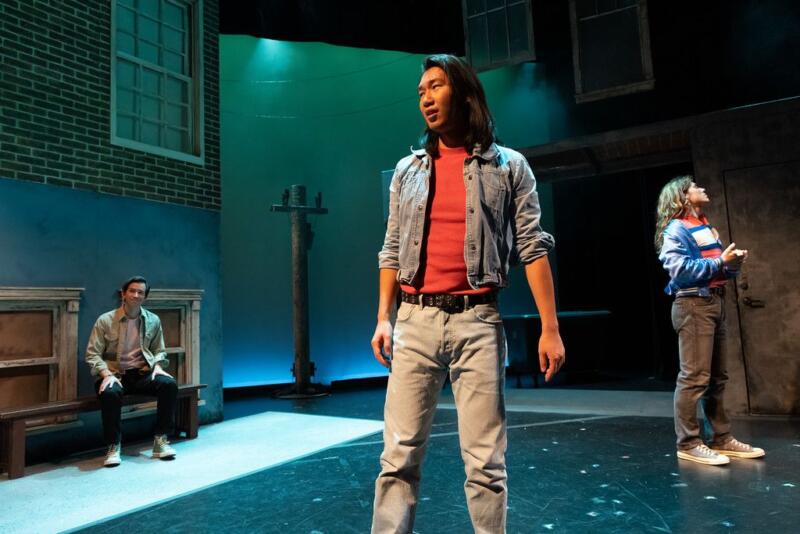1694 A history play for the ages
Michael Turner reviews
In My Day
by Rick Waines
Produced by Norman Armour, Rick Waines and Zee Zee Theatre
presented by The Cultch Theatre, Vancouver
December 02-11, 2022
*
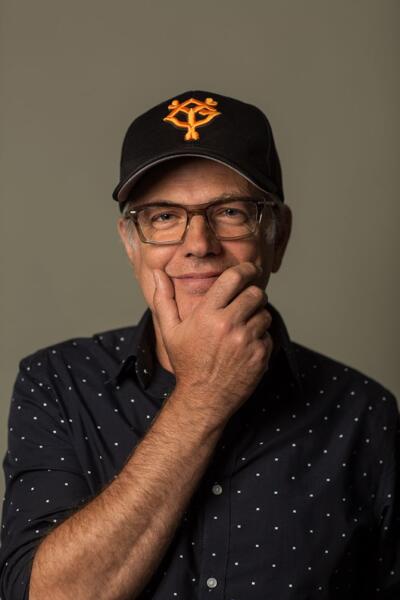
As a late-born North American Baby Boomer, I am not old enough to remember all the defining moments assigned to my generation. I was barely fifteen months when JFK was assassinated, and unaware of the Civil Rights Movement until the 1968 assassination of Martin Luther King, Jr. interrupted our regular program and my nanny put down her knitting to hug me and tell me what “a great man” he was, how “we must never judge each other by the colour of our skin.” It wasn’t until the early 1970s that I saw people of all colours and ages protesting the killing of innocent men, woman and children by American soldiers in Vietnam. Then Watergate happened, and shortly after that, one of my generation’s more colourful figures, the Yippie Jerry Rubin, appeared in Time magazine dressed in a suit and tie above the caption “Let’s make money together.” By the time the 1980s rolled around, the youngest of us were carrying on like our first-born predecessors ten years earlier, in a manner soon to be described as “unsafe.”
The HIV/AIDS pandemic represents the conclusion of a Boomer youth culture that began with an insistence on equality, liberation and experimentation. That this insistence passed from a critique of social relations (gender, class, race and sexuality) to a me-first hedonism enabled by the West’s historic exploitation of “developing” nations and Indigenous peoples forms a narrative that lends itself to a variety of moral arguments, from the Christian right to the Marxist Left. But unlike most post-war conflicts, HIV/AIDS first came to us not from without (the spectacle of urban “race riots”, bra burnings, strike breakings and foreign wars), but from within: a virus that has been identified, tracked and documented, one that remains with us despite the fact that many have consigned it to History — a discipline, I am told, whose North American university enrolment is declining at a historic rate.
Rick Waines’s play In My Day (2022) is a history project, “a verbatim drama,” he writes in his “Playwright’s Note”, “arranged from 118 interviews collected by an Oral History Research Project — HIV In My Day — out of the University of Victoria.” Waines’s subjects are “the living: those of us who survived.” It is his intention that the stories they contributed stand together as “a memorial to those who were left behind.”
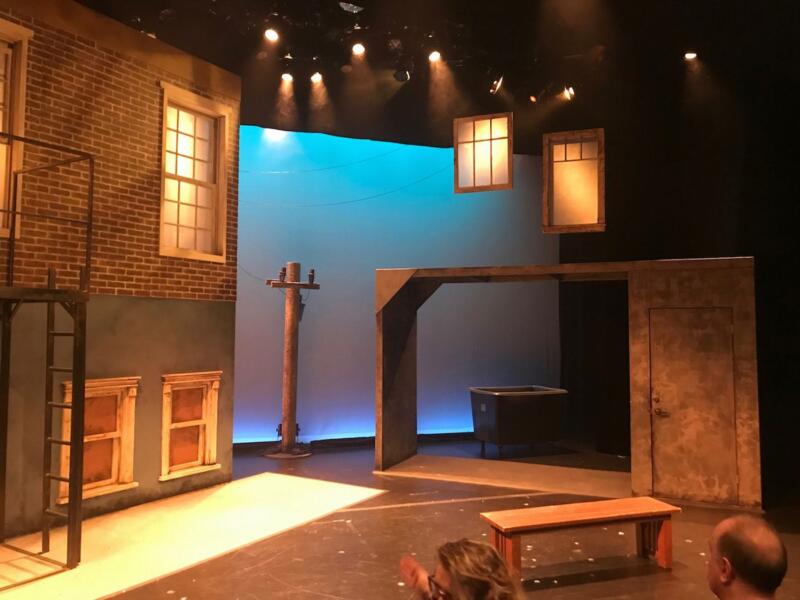
Presented in two acts, In My Day begins as most plays do, with a set. Here, designer Kimira Reddy gives us a two-toned, stucco-and-brick coulisse evocative of the West End’s iconic three-story walk-ups, where ground level windows and a fire escape put us not on the neighbourhood’s floral sidewalks, but in her unkempt alleys. To our right of the building is a telephone pole — a further reminder of where we are, and a symbol of the communication networks that, in the very early days of HIV/AIDS, were essential to the care of those suffering from what many (hospital workers included) feared could be as transmissible as the common cold. To the far right (and most ominously), an abstracted open structure with a zinc-coloured door; and “behind” it, a large four-legged vat. Above this structure hang two windows whose sunny glow complements an optimistic “blue sky” backdrop.
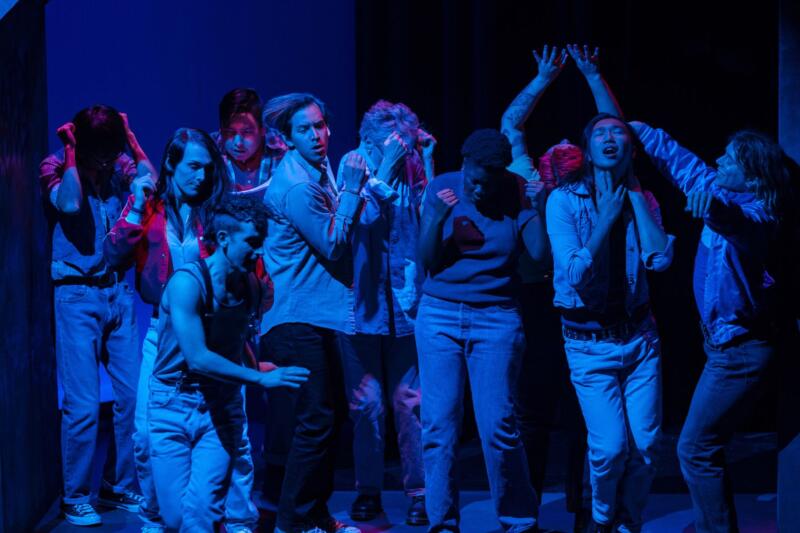
Contemplative silence is broken by two minutes of in-person housekeeping announcements, followed by a punch of funk music and a feathery convergence of eleven culturally-diverse actors moving about in twos and threes, guided by a lighting design (John Webber) in synch with Tara Cheyenne Friedenburg’s choreography, and what I am guessing is “Intimacy Direction” from Megan Gilron and Karyn Mott. Most of the actors appear to be in their twenties, with one conspicuously older, a white woman who resembles in presence (and soon enough in tone and content) sex education icon Sue Johanson. (Is she supposed to be Bonnie Henry?) But it is a younger actor (the only one wearing a COVID mask) who removes their mask to speak first — a mask that, in itself, speaks of our time, but also of a door, like the door the Stage Manager walks through at the start of Wilder’s Our Town (1938). Indeed, it is the “our town” of Vancouver that the actor speaks of: not in terms of railroad tracks and a Main Street, but its psycho-geography. It is a confident, emotionally intelligent voice, and in that moment that is all we need to know.
After a decentered, if not manic run of wellness propositions (led by the martinet-like older actor) an off-stage voice announces, as if in response: “Start at the beginning maybe. Back in the 1970s. Before the ashes and the urns.” It is here that the rhythms of the play begin to take shape, a gyre of interlocking vignettes featuring actors rotating through a range of roles and situations. And it is here, too, that we are able to focus on these actors, enough that, in many cases, even the most basic visual information is elusive. Am I watching a man? A woman? A man playing a woman. A woman playing an androgynous man? Should it matter? I share my inquisitiveness, my embarrassment, because mine is an older brain, admittedly conditioned by heteronormative categories that carry with them default meaning-making synapses; and it is only when I realize this (like the actor who took off their mask earlier) am I able to look and listen — not at gendered or even gender-divergent actors, but at angels channeling human stories. This was the first time I was moved to tears.
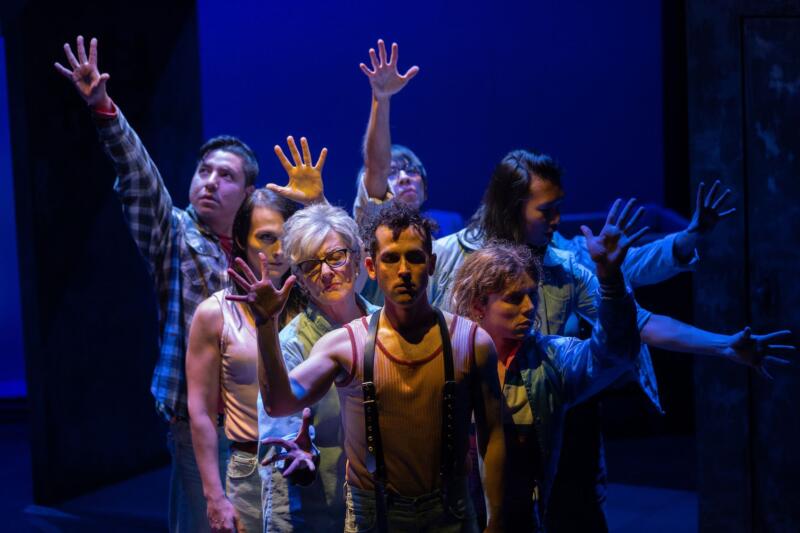
Soon enough, movement and attitude give way to subcultural particulars. For those old enough to remember: the Dufferin Hotel’s drag scene and its First Nations clientele. Pierre Trudeau’s name is dropped, along with his then-shattering line: “There is no place for the state in the nation’s bedrooms.” We hear of the first gay city councillors, how “the hookers kept the gays protected.” Returning momentarily to the future-present: how Robert Pickton “picked up sex workers in the West End.” And more clubs — the Gandydancer, the Edge and the Luv-a-Fair — an order that for many was a well-worn path from Saturday night into Sunday morning. Throughout these swirls, actors dance to “Love to Love You Baby”, lit up less by strobe lights than by gels that have more in common with gathering storm clouds. Rimbaud’s “The Blacksmith” is quoted. The word “cruising” enters the lexicon, and we hear of Stanley Park’s “fruit loop”, how “Anything can happen in the woods.” One actor tells the story of discovering a rash on his body, and asks, “Is this punishment for having sex with a man?” only to find out it is poison oak. A foreshadowing of things to come.
“Then things started to go sideways,” says another actor, solemnly. And the second time I was moved to tears — “It was fast.” New words enter the lexicon. “The Gay Cancer.” “The Gay Plague.” And an acronym I don’t remember: “GRID” (Gay-Related Immune Deficiency). It is here that those subcultural particulars turn subatomic, where only those who were in the thick of this crisis knew what was going on. Poppers (amyl nitrate) were suspect, as were fog machines. “People declared what they would and wouldn’t do sexually.” And to bring this declaration home, actors approximate a pick-and-choose buffet line at the vat, a kind of last supper standing that had me looking at my program to see who was responsible for this genius piece of direction.
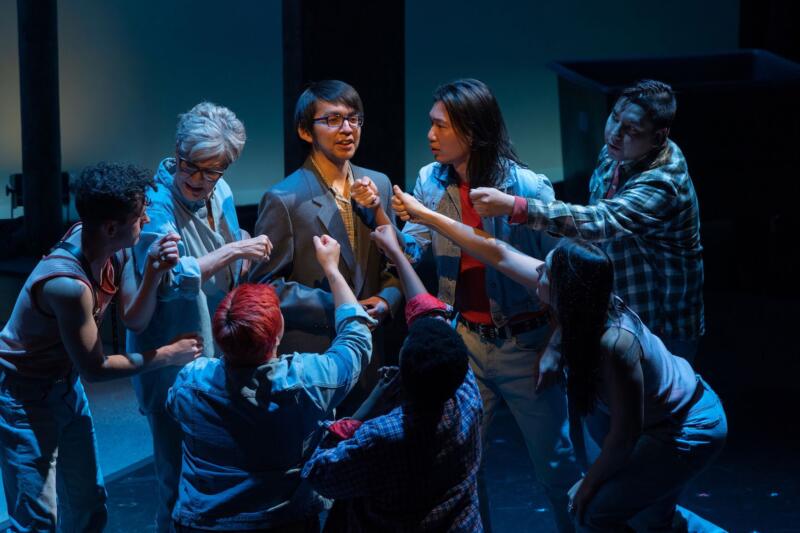
The action continues apace: a news item is shared concerning a woman charged for not disclosing she was HIV to the men who gang raped her; a confession: “I didn’t love myself enough to protect myself”; and in a statement that brings to mind how the COVID pandemic reveals the failings of our current health care system: “HIV enhanced the ways he felt immoral.” Again with the minutiae: a BC Ministry of Health sanctioned “Jackoff Club” at Studio J on Hastings St, whose “rules, rules, rules” included “No lips below the hips” and a gridded job board for the “volunteers who cleaned up.” St. Paul’s Hospital emerges as the HIV/AIDS primary care centre. There is talk of occupational “holes” popping up in Vancouver’s theatre community. Another remembrance: “Gay white men need to realize how much the lesbians did for us.”
The pace slows for the poignant story of a loathed cat orphaned by a community member and adopted by the cat’s biggest detractor, who allowed the cat her space, only to see her come around, fall in love with him. But then the pace picks up again: a “dead clothes” bank is formed; patrons no longer enquire about the sudden absence of a bar or restaurant regular; the annual Commodore Ball is established (“I came because this might be my last one,” and it was); and a remembrance of the now-defunct Westender newspaper, who published the names of those who’d passed.
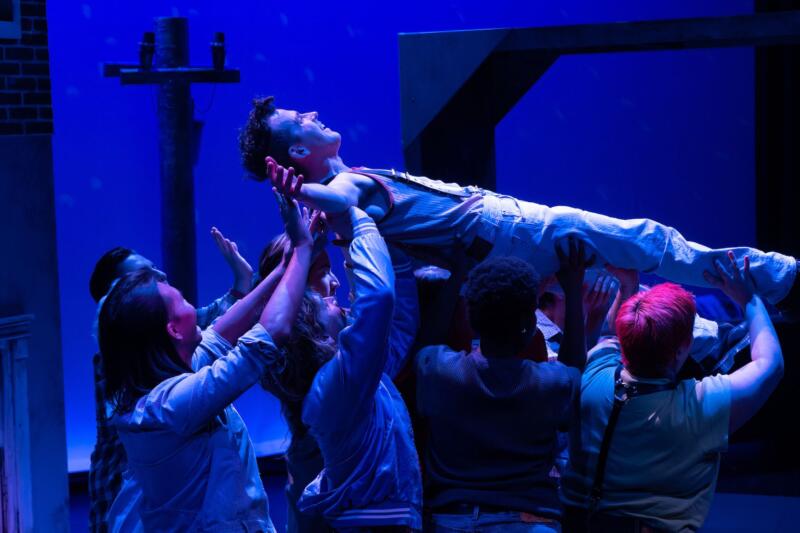
Though my recounting of events suggests a barrage of informational events (remember: “Things started to go sideways. It was fast”), the observations, anecdotes and vignettes are managed with a care that allows the conclusion of Act One its grace, broken only by an awkwardly placed exegesis on HIV and hemophiliacs, some of whom contracted the virus through blood transfusions. Given that Act Two is quick to mention intravenous drug use and sex work as transmission streams, might “tainted blood” transfusions have been better placed among them?
The best argument for a two-act play is an Intermission that allows theatre-goers to gather the experience of the first act and ponder how the playwright might open Act Two. In this instance, Waines sounds like Twain (Mark, not Shania): “History never repeats itself, but it does often rhyme.” From here we are presented with an artful recounting of 20th century identitarian-based protest movements, with tableaux that include the 1960s civil rights marches and 1970s women’s liberation, before introducing us to what is arguably 1980s biggest body-oriented demo: ACT UP. In contrast, Waines inserts appearances by then-B.C. Premier Bill Vander Zalm, an Ayn Rand libertarian and unrepentant ally of the North American religious right. Pitted against Vander Zalm is John “Cause a stinko” Kozachenko, a co-founder of Vancouver’s ACT UP chapter and Persons With AIDS (PWA), the latter an advocacy group that, with the more equanimous AIDS Vancouver, were key players in bringing HIV/AIDS into public — and political economic — consciousness.
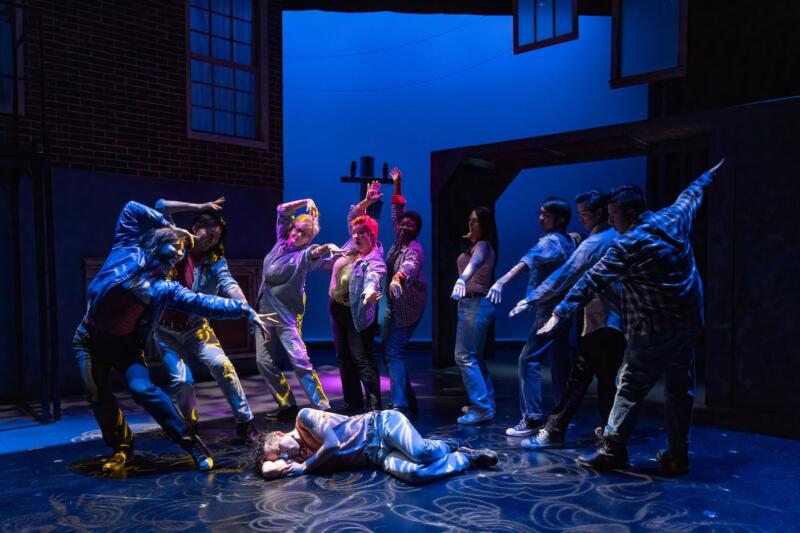
But as with most ad hoc groups, even the best-intended can become more about the organization (“they started to feel like a social services agency”) than the sick and suffering who brought them into being. An Indigenous actor tells of going to PWA and finding it “all white people.” From there, intersectional issues abound, taking the form of disputes over the needs of “gay versus straights,” social class differences (“Identity politics started to rip us apart”). The arrival of the “BMW Ladies” (wealthy West Van volunteers) would be comic if the stakes weren’t so high. To Waines’s credit, this segment is presented less as comedy than through that most lethal of art forms: burlesque. Following that, an equally outrageous treatment of the first anti-viral drugs, their precise and very visible effect on the body (“the vomit and the shitting”); a visibility that is not so much depicted from or on the body (lipodystrophy), but held over it in form of an out-sized capsule marked ROCHE.
As a work of memorial art, it is fitting that In My Day concludes with the actors gathering at the AIDS Memorial at Sunset Beach (“Every year I try to go and trace a name, leave flowers”). Like the names of the dead, and the flowers left behind in their honour, the actors take turns laying down tweet-sized pensées: “The carnival is over.” “I’m tired.” “Had to take fifteen years of death messages.” “Tired of waiting for the latest drug.” And soon enough, like the cycling gyre, the turn: “You’re here.” “I’m alive — no one else is.” “Alone at Christmas, birthdays.” “A shame that if in ten years people will ask, ‘What was AIDS?’” “Is it part of the collective memory?” Still turning: “What does the community remember?” “What makes us happy?” “I think we’ve had our say.” “I told you we had a story.”
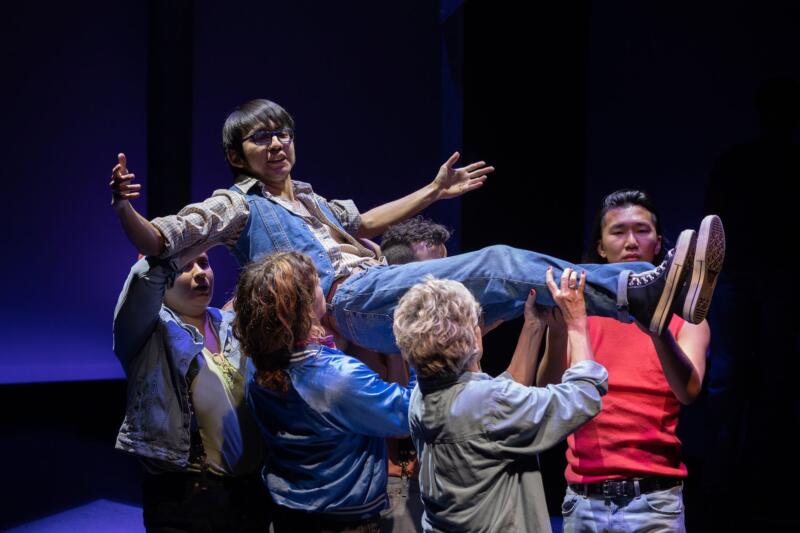
It is said that form follows function. If HIV/AIDS has a visual art form, it might well be the gridded quilt, like the many quilts that were jointly made and displayed by the families and friends of those who, during the pandemic’s first 15 years, suffered, passed away and continue to suffer from the virus. But theatre being a performing art, one that moves freely given the particularities of its participants’ bodies, it has the capacity to traverse the static right-angled strictures of the grid, allowing for many movements, many voices, a swirling permutating chorus that forsakes didacticism for that great 20th century aesthetic innovation: collage.
Like the quilter, Waines has drawn from the Oral History Research Project fabric bag to give us a remarkable play that is not simply informational and emotional, but a work of art presented in a form that feels true to experience of knowing, not knowing, unknowing and becoming, where the theatre-goer’s experience is less a lesson in what happened than an immersion in a Brechtian condition (Stimmung?). Assisting in this immersion is Shawn Macdonald’s brilliant direction and dramaturgy, not to mention a mostly twenty-something cast who brought to mind the precocious prepubescent energy of the kids from the PBS series Zoom (1972-1978), but with a nuance and understanding beyond their years, if not a human lifetime. Did I not describe these actors as angels? I did. And as I write this now, I am moved to tears once more.
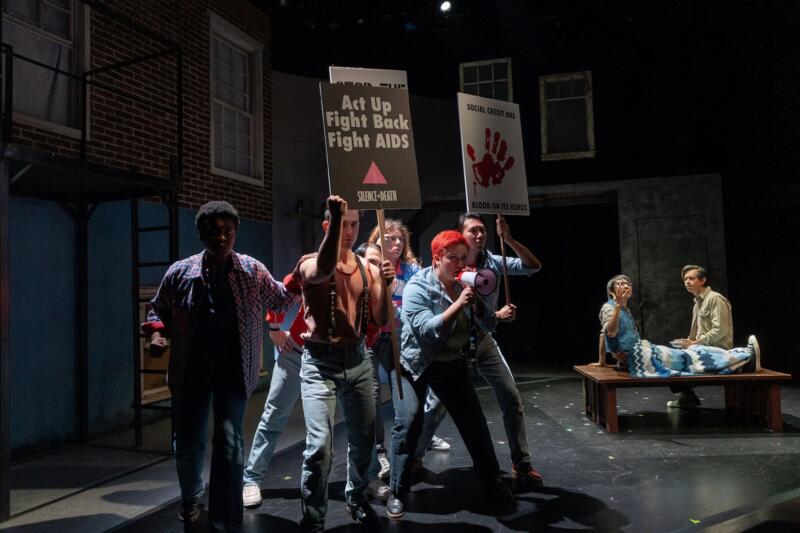
*
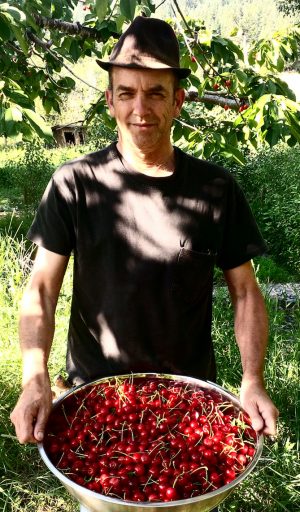
Michael Turner is a writer of variegated ancestry (Scottish/ German/ Irish, mat.; English/ Japanese/ Russian, pat.) born, raised and living on unceded Coast Salish territory. He works in narrative and lyric forms, both singularly, as a writer of fiction (American Whiskey Bar, The Pornographer’s Poem, 8×10), poetry (Hard Core Logo, Kingsway, 9×11), criticism and music, and collaboratively, with artists such as Stan Douglas (screenplays), Geoffrey Farmer (public art installations) and Fishbone, Dream Warriors, Kinnie Starr and Andrea Young (songs). His work has been described as intertextual, with an emphasis on “a detailed and purposeful examination of ordinary things” (Wikipedia). He holds a BA (Anthropology) from UVic and an MFA (Interdisciplinary Studies) from UBC Okanagan. Currently he is an Adjunct Professor in the Faculty of Liberal Arts and Sciences and School of Interdisciplinary Studies and Graduate Studies, Ontario College of Art & Design University and a workshop leader at Mobil Art School, Vancouver. Editor’s note: Michael Turner has recently reviewed books by Liz Magor, Sheryda Warrener, Marius Kociejowski, Larissa Lai, Emma Cleary et al., and Tara Borin for The British Columbia Review.
*
The British Columbia Review
Publisher and Editor: Richard Mackie
Formerly The Ormsby Review, The British Columbia Review is an on-line book review and journal service for BC writers and readers. The Advisory Board consists of Jean Barman, Wade Davis, Robin Fisher, Barry Gough, Hugh Johnston, Kathy Mezei, Patricia Roy, Maria Tippett, and Graeme Wynn. Provincial Government Patron (since September 2018): Creative BC. Honorary Patron: Yosef Wosk. Scholarly Patron: SFU Graduate Liberal Studies.
“Only connect.” – E.M. Forster
